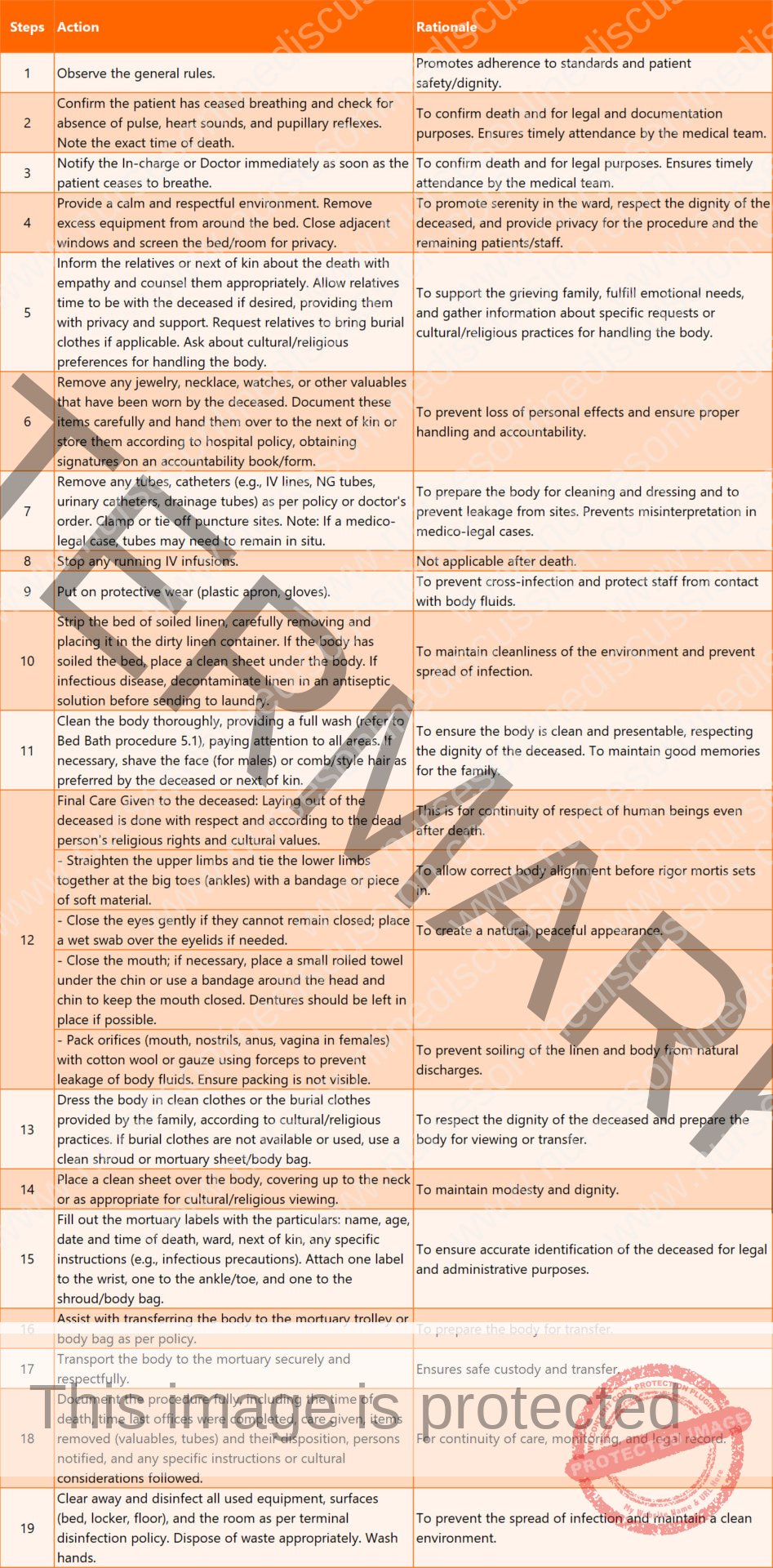Specialized Nursing Care
Subtopic:
Last Office
Table of Contents
Last offices (also known as post-mortem care or care of the deceased) is the care given to a deceased person to ensure a clean body and maintain dignity, respect, and prepare the body according to cultural, religious, and legal requirements.
Aims:
- To prepare the deceased for mortuary or a funeral home or morgue (a place where dead bodies are kept pending identification, autopsy or burial.
- To minimize any risk of cross infection to relatives, health care workers or persons who may need to handle the deceased.
Requirements:
Trolley (Top Shelf):
- Two jugs of warm and cold water Small tray with:
- Soap in a dish
- Nail brush
- Vaseline or lubricant
- Comb
- Nail cutter
- Pair of scissors 2 Receivers (kidney dishes) Dissecting forceps (or artery forceps) – often for packing orifices Mortuary labels with tapes (at least 3 – wrist, toe, and shroud) A roll of toilet paper (or cotton wool) Brown cotton wool in a bowl (for packing orifices) – Note: Brown cotton wool is less common now; plain cotton wool or gauze is typically used. Dressing pack (or sterile pack with swabs) Flannels (or washcloths) Antiseptic lotion Jik (or other disinfectant for surfaces/equipment)
Trolley (Bottom Shelf):
- Plastic apron
- 2 pairs of clean sheets (one for the bed, one for the shroud)
- Dressing mackintosh and sheets
- A pair of mortuary sheets (or shroud/body bag)
- Strapping and sticking plaster (adhesive tape/bandage)
- Notification of death forms
- Bottle of antiseptic lotion (for washing body)
- 2 buckets (one containing disinfectant solution for contaminated items) Bedside:
- Hand washing equipment (access to sink, soap, water, towel)
- Screens (for privacy)
- Bucket for wastes (clinical and general)
- Dirty linen container
Deceased Burial Clothes:
- Clean sheets
- Dressing clothes as preferred by family/culture (e.g., Men – underwear, trousers, shirt, coat, tie; Traditional wear according to culture or religion).
- Diapers/pads (if needed)
Procedure (Preliminary Steps & First Phase):

Key Points (Adult Last Offices):
- Maintain a calm, quiet, and respectful atmosphere throughout the procedure.
- Always handle the deceased body gently and with dignity.
- Be sensitive to the cultural and religious beliefs of the patient and family regarding death and body preparation. Consult with the family or spiritual advisors if unsure.
- If the death is a medico-legal case, follow specific protocols regarding removal of tubes, handling of clothing, and notification of authorities.
- Ensure proper identification of the body with labels before transfer to the mortuary.
- Wash hands thoroughly before and after the procedure.
- Terminal disinfection of the patient’s unit is essential.
LAST OFFICE IN PERINATAL DEATH
Objectives:
- Define the term perinatal mortality.
- Display the ability to break news of death and counsel the parents of a deceased baby.
- Identify the requirements for carrying out last office to a deceased new born baby.
- Prepare the requirements for carrying out last office to a deceased new born baby.
- Perform last office of the deceased new born baby.
Definition:
Perinatal mortality is the death of a baby in the first 28 days of life, including stillbirths (death before birth after 28 weeks gestation).
Requirements (Perinatal Death):
Additional requirements to adult last office requirements:
- Baby clothes (as provided by parents/family)
- Diapers (or pads)
- Small artery forceps (for packing orifices)
- Small blanket or receiving cloth (for wrapping the baby)
- Mortuary label (specifically for stillbirths/neonates)
.
Procedure (Last Office in Perinatal Death):

Key Points (Perinatal Death):
- Be exceptionally sensitive, supportive, and compassionate when caring for parents experiencing perinatal loss.
- Allow parents adequate time to see and hold their baby if they wish. This is a vital part of the grieving process.
- Provide privacy for the family. Ideally, the last offices for a perinatal death should be performed in a separate room, not in the main ward where other mothers with babies are present.
- Ensure the environment is quiet and conducive to grieving.
- Handle the baby gently and with the utmost respect throughout the procedure.
- Follow hospital policy and cultural/religious practices regarding the disposition of the body.
- Minimize psychological trauma for the mother and family.
- Ensure appropriate follow-up support is offered to the parents.
Related Topics
- Wound dressing
- Colostomy Care
- Abdominal Paracentesis(Abdominal Tapping)
- Vulva Toilet/ Swabbing
- Oxygen Administration
- Lumbar Puncture
- Nasogastric tube to feed patients
- Gastrostomy Feeding
- Gastric Lavage
- Catheterization
- Tracheostomy Care
- Caring for patients in traction
- Prepare for application of orthopaedic splints
- Bandaging
- Nursing Process
- Take History of the patient
- Perform a physical examination of the Patient
- Making a Nursing Care Plan
- Admission of a patient
- Drug administration
- Transfer Patients
- Discharge of patients
- Last Office
Get in Touch
(+256) 790 036 252
(+256) 748 324 644
Info@nursesonlinediscussion.com
Kampala ,Uganda
© 2025 Nurses online discussion. All Rights Reserved Design & Developed by Opensigma.co

